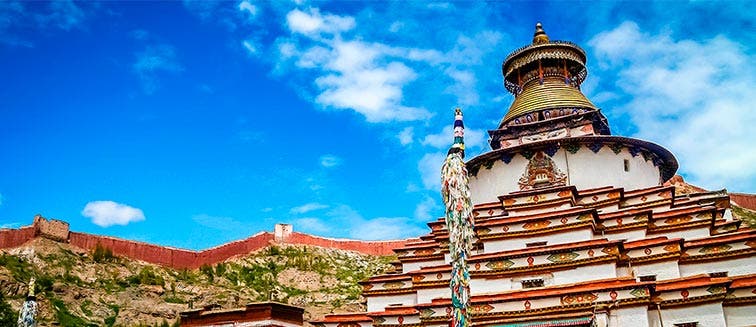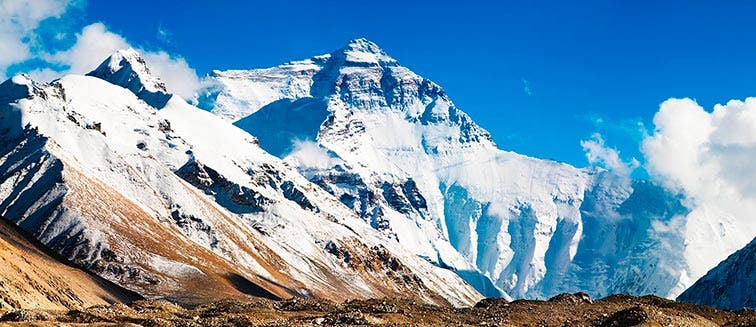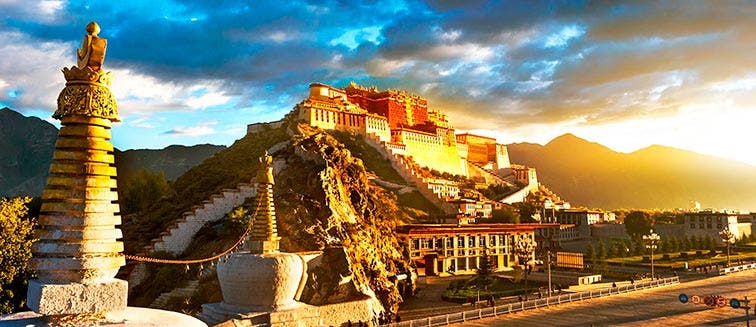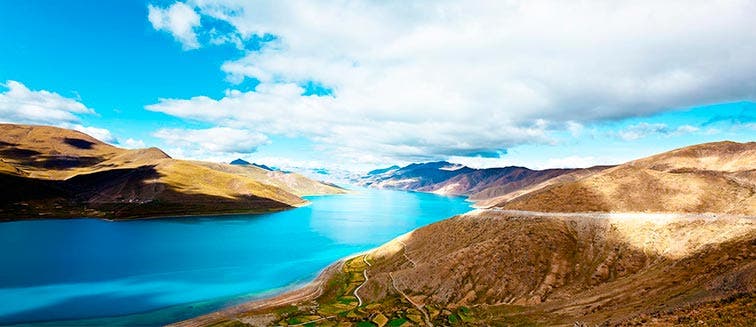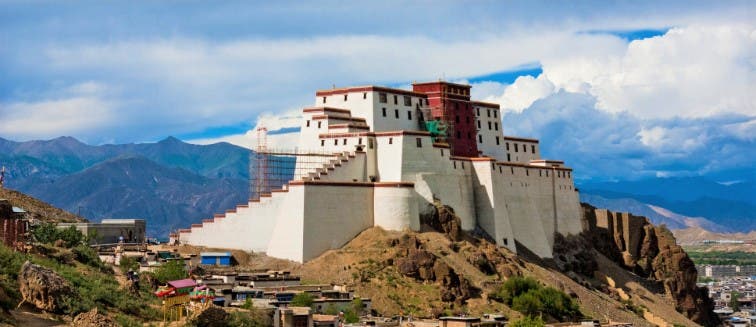Africa
Americas
Asia
Europe
Oceania
Holidays to Europe (93 available)
Albania(2)
Austria(6)
Baltic States(3)
Belgium(5)
Croatia(3)
Cyprus(1)
Czech Republic(5)
Denmark(1)
England(10)
Finland(2)
France(13)
Germany(7)
Greece(10)
Holland(5)
Hungary(4)
Iceland(6)
Ireland(9)
Italy(13)
Montenegro(1)
Northern Ireland(2)
Norway(9)
Portugal(9)
Romania(1)
Scotland(6)
Slovakia(1)
Spain(9)
Sweden(2)
Switzerland(4)
By Season
By Interest
By Group
What to see in Tibet
Gyantse
- Vacations to Tibet
- Points of Interest
Tourist attractions Gyantse
The small town of Gyantse, located 274 km southwest of Lhasa on the well-known Friendship Highway, links the capitals of Tibet and Nepal. It is 3977 meters above sea level and located in the fertile plain of the Nyangchu river valley, so its main economic structure depends on agriculture and livestock.It is a must for tourists who want to experience authentic Tibet. A walk through the intact old quarter is enough to breathe the essence of its traditional culture, its historical importance and its genuine Tibetan flavor, which survives despite the Chinese government's efforts to modernize the country.In the 15th century, during its golden years, it became the third most important city in Tibet due to its strategic location on the commercial route with India, where it stood out for its impressive wool carpets.Like most Tibetan monasteries, the Pelkor Chode has an outer wall that marks the boundaries of the complex. On the other side of the walls, there is a temple with a reddish brown facade and a chorten or Tibetan stupa. It was built in the 15th century and is the only one in the country that has monks from different Buddhist disciplinary schools, such as the Order of the Yellow Caps, the Sakya and the Kadampa living in harmony with each other. Its architectural style mixes Tibetan, Nepalese and ethnic Han influences. Inside the main temple of Tsulaklakang is the Audience Hall, where there are two thrones, one for the Dalai Lama and one for the main Sakya Lama. At the back of the room is the most important Tsangkhang shrine, whose walls are adorned with beautiful wall paintings and where there is a bronze statue of Shakyamuni flanked by carvings of other deities.Next to the monastery stands the Chorten or Kumbum, one of the jewels of Tibetan art. Built in 1418, it is 35 meters high and is the oldest, highest, best preserved and the most important in the country.This large stupa covered with plaster painted white, consists of 9 levels that decrease in size as they increase in height. The first 5 have a square plan with a three-dimensional mandala shape and 77 doors, each of which gives access to chapels or sanctuaries that house clay sculptures, beautiful thangkas and exquisite mural paintings, hence the origin of the name Kumbum which means "One Hundred Thousand Images", alluding to the large number of Buddha representations that it houses. The 4 upper levels are circular and on the sides of the 7th, the eyes of wisdom are drawn, symbolizing the divine consciousness in everything that exists. It is topped by a dome decorated with 13 golden rings that represent the successive stages of approach to the founder of Buddhism. The building is circled following the kora in a clockwise direction as a sign of respect.The Gyantse Dzong is the great fortress that crowns one of the hills of the valley and dominates the city. It was built in 1390 and includes a series of buildings with sturdy and high whitewashed walls, small windows and a decorative red painted strip that runs around the upper of the building. The remains of the old walls from the 9th century that surrounded the city add to the construction giving it a certain medieval air and meander along the side of the mountain for 3 km. Inside it houses a museum, but the most interesting thing is to admire the photogenic views of the city from the top of the Dzong.Gyantse is also known as the "city of heroes" because of its extraordinary resistance to the British imperialist invasion that arrived in the region in 1904. Later, in 1959, the city was devastated during the Chinese Cultural Revolution, when the monks were persecuted and the monastery damaged and plundered, although it was later repaired.Traveling to Gyantse is one of the most rewarding experiences you can experience in this remote country. Witnessing first-hand the charm of this city and how it has preserved its beauty despite the adverse historical constraints, will make a tour of Tibet even more worthwhile.
We don't have any trips to Gyantse at the moment.
Subscribe to our newsletter to not miss any trips
YOU ALSO LIKE
China
3 Trips
Hong Kong
1 Trips
Japan
9 Trips
Mongolia
Notify me when available
South Korea
6 Trips
Taiwan
Notify me when available
Tibet
Notify me when available
Turkey
8 Trips
Jordan
5 Trips
Israel
Notify me when available
Armenia
Notify me when available
Uzbekistan
2 Trips
Oman
Notify me when available
Lebanon
Notify me when available
Kazakhstan
1 Trips
Kyrgyzstan
Notify me when available
Qatar
4 Trips
Bahrein
1 Trips
Cambodia
4 Trips
Thailand
6 Trips
Vietnam
7 Trips
Myanmar
Notify me when available
Indonesia
9 Trips
Malaysia
2 Trips
Philippines
2 Trips
Singapore
2 Trips
Laos
Notify me when available
India
10 Trips
Bhutan
2 Trips
Nepal
5 Trips
Sri Lanka
5 Trips
Maldives
5 Trips
United Arab Emirates
3 Trips
Saudi Arabia
2 Trips
Tourist attractions tibet
Points of interests
Other Points of interests
- Trips to Andong
- Trips to Beijing
- Trips to Busan
- Trips to Chengdu
- Trips to Chongqing
- Trips to Dunhuang
- Trips to Gion’s geisha district
- Trips to Great Wall
- Trips to Guilin
- Trips to Gyeongju
- Trips to Hakone
- Trips to Hangzhou
- Trips to Hiroshima
- Trips to Hokkaido
- Trips to Hong Kong
- Trips to Huangshan
- Trips to Jeju Island
- Trips to Jeonju
- Trips to Jiuzhaigou National Park
- Trips to Kanazawa
- Trips to Kumano Kodo
- Trips to Kyoto
- Trips to Lantau Island
- Trips to Lhasa
- Trips to Li River
- Trips to Matsumoto
- Trips to Mount Fuji
- Trips to Mount Koya
- Trips to Nagoya
- Trips to Nara
- Trips to Nikko
- Trips to Okinawa
- Trips to Osaka
- Trips to Repulse Bay
- Trips to Sapporo
- Trips to Seoul
- Trips to Shanghai
- Trips to Shibuya Crossing
- Trips to Shirakawa-go
- Trips to Stanley Market
- Trips to Suzhou
- Trips to Taipei
- Trips to Takayama
- Trips to Three Gorges Dam
- Trips to Tokyo
- Trips to Ulaanbaatar
- Trips to Victoria Peak
- Trips to West Lake
- Trips to Wuxi
- Trips to Xi'an
- Trips to Yangshuo
- Trips to Yangtze river
- Trips to Yeosu
- Trips to Zhangjiajie
Countries Nearby
- Armenia Trips
- Bahrein Trips
- Bhutan Trips
- Cambodia Trips
- China Trips
- Hong Kong Trips
- India Trips
- Indonesia Trips
- Israel Trips
- Japan Trips
- Jordan Trips
- Kazakhstan Trips
- Kyrgyzstan Trips
- Laos Trips
- Lebanon Trips
- Malaysia Trips
- Maldives Trips
- Mongolia Trips
- Myanmar Trips
- Nepal Trips
- Oman Trips
- Philippines Trips
- Qatar Trips
- Saudi Arabia Trips
- Singapore Trips
- South Korea Trips
- Sri Lanka Trips
- Taiwan Trips
- Thailand Trips
- Tibet Trips
- Turkey Trips
- United Arab Emirates Trips
- Uzbekistan Trips
- Vietnam Trips
Trip Styles
Susbscribe to our newsletter and join Exoticca GO
The best travel deals
Exclusive promotions
Expert travel tips
